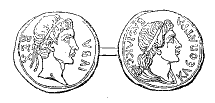Juba II
[2] Through dedication to his studies, he is said to have become one of Rome's best educated citizens, and by age 20 he wrote one of his first works entitled Roman Archaeology.While growing up, Juba II accompanied Octavian on military campaigns, gaining valuable experience as a leader.[8] When Juba II and Cleopatra Selene moved to Mauretania, they named their new capital Caesaria (modern Cherchell, Algeria), in honour of Augustus.The construction and sculpture projects at Caesaria and another city, Volubilis, display a rich mixture of Egyptian, Greek and Roman architectural styles.Juba II sent a contingent to Iles Purpuraires to re-establish the ancient Phoenician dye manufacturing process.Pliny the Elder refers to him as an authority 65 times in the Natural History and in Athens, a monument was built in the Gymnasium of Ptolemy in recognition of his writings.[17] Others can be found in Athenaeus, Plutarch, Claudius Aelianus Harpokration, Dioscórides, Galen, Philostratus, Herodian, Tatian, Ammianus Marcellinus, Solinus, Hesychius of Miletus, Stephanos of Byzantium, Photios, the Etymologicum Magnum, the Geoponica and various scholia on classical authors.Flavius Philostratus recalled one of his anecdotes: "And I have read in the discourse of Juba that elephants assist one another when they are being hunted, and that they will defend one that is exhausted, and if they can remove him out of danger, they anoint his wounds with the tears of the aloe tree, standing round him like physicians."[21] Juba's Greek physician Euphorbus wrote that a succulent spurge found in the High Atlas was a powerful laxative.[22] Botanist and taxonomist Carl Linnaeus assigned the name Euphorbia to the entire genus in the physician's honour.

Louvre MuseumNumidiaJuba IRoman RepublicEmpireMauretaniaBocchus IIPtolemy of MauretaniaCleopatra Selene IIGlaphyra of CappadociaAncient GreekclientCleopatra VIIPtolemaicMark AntonyBerberJuba I of NumidiaHannibalJulius CaesarThapsusPompeyromanizedAugustusBattle of ActiumRoman EmpireRoman provinceAfrica ProconsularisStraboCherchellAlgeriaVolubilisEgyptianTipazagrapesIles PurpurairesTangierStrait of GibraltarCádizCartagenaDuovirhistorianPlutarchGaius CaesarRoyal Mausoleum of MauretaniaNumidianobverseRoman naming conventionsDrusillaGlaphyraCappadociaAlexanderHerod the GreatHerod ArchelausEthnarchPliny the ElderAthensHanno the NavigatorAthenaeusNatural HistoryClaudius AelianusHarpokrationDioscóridesPhilostratusHerodianTatianAmmianus MarcellinusSolinusHesychius of MiletusStephanos of ByzantiumPhotiosEtymologicum MagnumGeoponicascholiaFulgentiushomonymPliny the YoungerCanary IslandsMadeiraFlavius PhilostratusEuphorbussucculentspurgelaxativeEuphorbiaAntonius MusaCarl LinnaeusEuphorbia regis-jubaepalm treeJubaeaParallel LivesWorld History EncyclopediaWayback MachineRealencyclopädie der Classischen AltertumswissenschaftHistory TodayDictionary of Greek and Roman Biography and MythologyEncyclopædia Britannica
